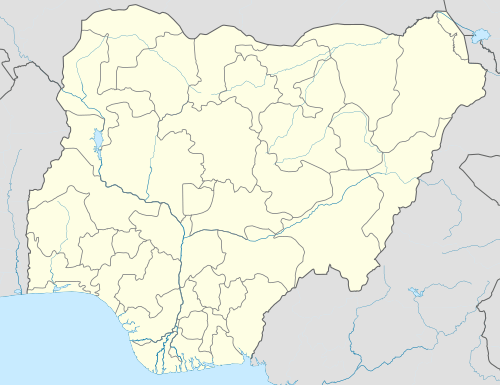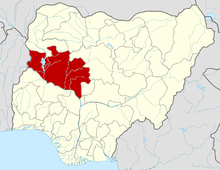Bida
Bida is a Local Government Area in Niger State, Nigeria and a city on the A124 highway which occupies most of the area.[1]
Bida | |
|---|---|
LGA and city | |
 Bida North Central | |
| Coordinates: 9°05′N 6°01′E | |
| Country | |
| State | Niger State |
| Government | |
| • Local Government Chairman and the Head of the Local Government Council | Sheshi Suleiman |
| • Etsu | Yahaya Abubakar |
| Area | |
| • Total | 1,698 km2 (656 sq mi) |
| Population (2006 census) | |
| • Total | 266,008 |
| Time zone | UTC+1 (WAT) |
| 3-digit postal code prefix | 912 |
| ISO 3166 code | NG.NI.BI |
The LGA has an area of 51 km² and a population of 188,181 at the 2006 census.
The postal code of the area is 912.[2]
The city
Bida is the second largest city in Niger State with an estimated population of 178,840 (2007).[3] It is located southwest of Minna, capital of Niger State, and is a dry, arid town.[4]
Districts include Katcha, Enagi, Baddeggi, Agaie, Pategi, Lemu, Kutigi, and others.
There are other places in Bida such as Bamisu estate, Ramatu dangana, ECWA poly road, Small Market, Main Market and the Federal Medical Centre (Bida) others. There are also different schools like Federal Government Girls College Bida, Federal Polytechnic Staff Secondary School, Government College, Bida and others.[5][6]
Economy
The town is known for its production of traditional crafts, notably glass, bronze articrafts and brass wares. Bida is also known for its Durbar festival and the Nupe Day Festival. It is also the home to the Federal Polytechnic, Bida, Federal Medical Centre and Niger State School of Nursing.[7]
Ethnicity
The major ethnic group is the Nupe. Bida is the headquarters of the Nupe Kingdom led by the Etsu Nupe (presently Etsu Yahaya Abubakar). The leadership style of the ancient town of Bida is emirship, and the head of the town is addressed as Etsu Nupe. Other tribes include Igbo, Yoruba, Hausa, Igala and Gbagi, Ibira.[8][9]
See also
References
- North Central State, Nigeria. Survey Department. (1970), Bida., OCLC 5486416
- "Post Offices- with map of LGA". NIPOST. Archived from the original on 7 October 2009. Retrieved 2009-10-20.
- "The World Gazetteer". Archived from the original on 2007-09-30. Retrieved 2007-03-27.
- Olatunji, Ayo; A. Diugwu, Ikechukwu (2013-08-03). "A Project Management Perspective to the Management of Federal Roads in Nigeria: A Case Study of Minna-Bida Road". Journal of Finance and Economics. 1 (4): 54–61. doi:10.12691/jfe-1-4-1. ISSN 2328-7284.
- CE, Amiwero; EA, Nelson; M, Yusuf; OF, Olaosebikan; MAN, Adeboye; UG, Adamu; C, Oladele; JS, Busuyi; SA, Erinle; A, Babalola (2017). "Knowledge, Awareness and Prevalence of Viral hepatitis Among Health Care workers (HCWs) of the Federal Medical Centre Bida, Nigeria". The Journal of Medical Research. 3 (3): 114–120. doi:10.31254/jmr.2017.3306. ISSN 2395-7565.
- Nigerian Library Association. Niger State Chapter. Annual Conference (2nd : 2017 : Bida, Nigeria). Proceedings of the Annual Conference, Bida 2017. OCLC 1074126465.
- Hugh, Vernon-Jackson (1960). "Craft Work in Bida". Africa. 30 (1): 51–61. doi:10.2307/1157742. ISSN 0001-9720. JSTOR 1157742.
- Mason, Mike, 1938- (1981). Foundations of the Bida Kingdom. Ahmadu Bello University Press. ISBN 978-125-012-7. OCLC 12134929.CS1 maint: multiple names: authors list (link)
- W. E, Nicholson (1934). "89. Bida (Nupe) Pottery". Man. 34: 71–73. doi:10.2307/2790654. ISSN 0025-1496. JSTOR 2790654.
